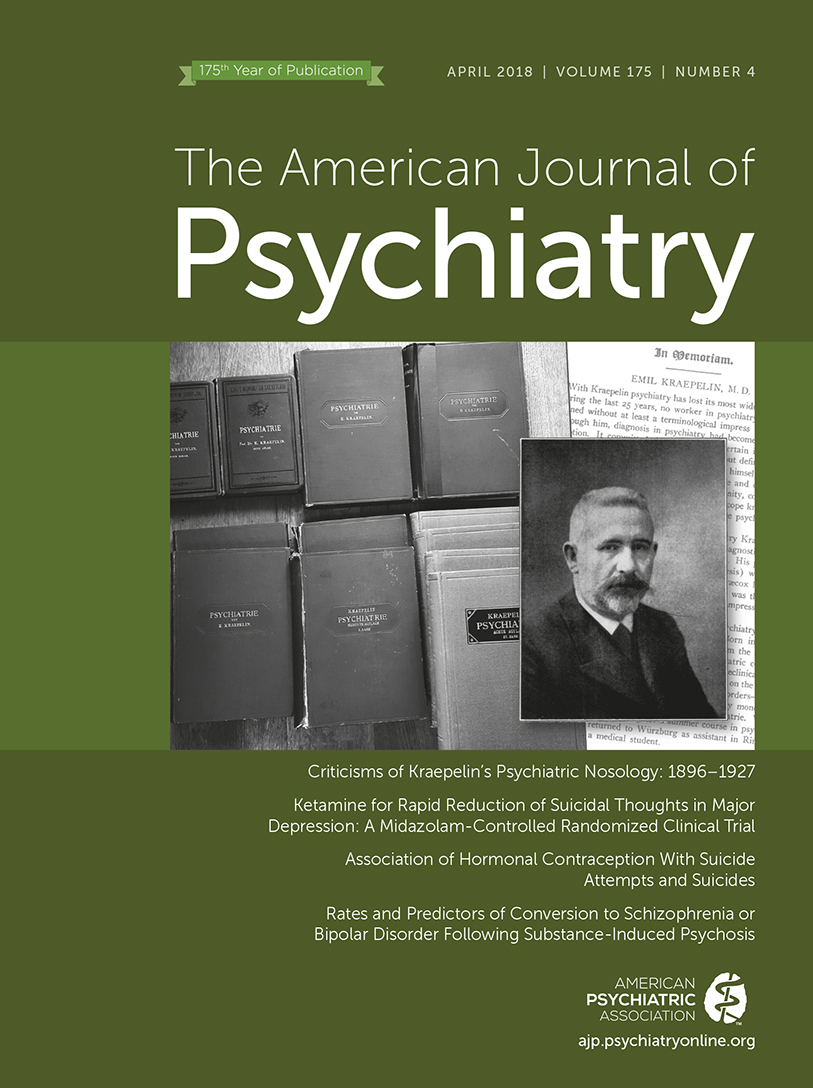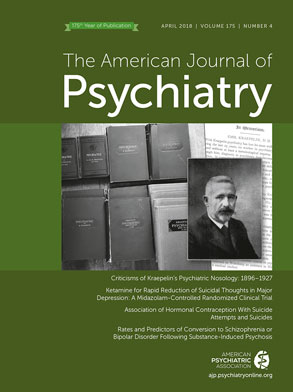“It was the best of times, it was the worst of times, it was the age of wisdom, it was the age of foolishness, it was the epoch of belief, it was the epoch of incredulity, it was the season of light, it was the season of darkness, it was the spring of hope, it was the winter of despair.”
—Charles Dickens, A Tale of Two Cities
The choice of a title for this commentary was not willy-nilly, but quite deliberate. Our field very much wants and needs to know where the ketamine story is going. Here, I attempt to succinctly summarize the ketamine story in the context of the recent findings reported by Grunebaum and colleagues (
1) in this issue.
Ketamine, administered parenterally, was approved by the U.S. Food and Drug Administration (FDA) in 1970 for general anesthesia. For the next 20 years, ketamine was exclusively used for this indication. In 1990, Berman et al. (
2) reported on a saline-controlled clinical study of seven patients showing that a low, subanesthetic dose of ketamine possessed antidepressant properties. This was followed several years later by a virtual avalanche of studies that have sought to confirm and extend those initial observations on the beneficial effects of ketamine on depressive symptoms and suicidality. In my capacity as Chair of the APA Task Force on Biomarkers and Novel Treatments, I have been a contributor to the meta-analysis of the ketamine treatment database (
3) and the recent expert consensus report on its use in the treatment of depression (
4), as well as several commentaries (
5,
6).
There is little debate over the antidepressant effects of intravenously administered low-dose (0.5 mg/kg) ketamine in major depressive disorder and bipolar depression (the interested reader can refer to recent reviews in references
4,
7). The antidepressant effects are clear but transient, with most but not all studies observing the effects abating by 7 days postinfusion. There is substantially less information on the beneficial and adverse consequences of repeated ketamine administration. This is of paramount importance, because the excitement about ketamine in our field is a reflection of the serious challenges we face in managing treatment-resistant depression. Estimates vary, but even in the Predictors of Remission in Depression to Individual and Combined Treatments (PReDICT) team’s recent study of never-treated depressed patients randomly assigned to receive escitalopram, duloxetine, or cognitive-behavioral therapy (
8), remission rates were approximately 50%. The National Institute of Mental Health–funded Sequenced Treatment Alternatives to Relieve Depression (STAR*D) trial found a remission rate of only 28% with citalopram monotherapy (
9). In addition, treatment-resistant depression is associated with reduced life expectancy because of an increased risk for suicide as well as major medical disorders, including myocardial infarction, diabetes, and others.
Suicide is the 10th most common cause of death in the United States and the only one in the top 10 increasing in rate and number. Grunebaum et al. (
1), in a very well designed study of suicidal inpatients with major depression randomly assigned to receive intravenous ketamine or midazolam (an “active” control), found a significant antisuicidal effect of ketamine, an effect maintained for up to 6 weeks when combined with optimized pharmacotherapy. The enantiomer of ketamine, esketamine, administered intranasally, is currently being studied by Janssen Pharmaceuticals in patients with major depression and prominent suicidality. With all of these positive results, in spite of a database that is a mere fraction of what the FDA would normally require for approval, why all this concern? The concerns can be simply classified in five main categories:
1.
Who regulates or should regulate the use of ketamine for the treatment of major depression, posttraumatic stress disorder (PTSD), and other psychiatric disorders? Related to this question is another: What oversight is currently in place for the myriad of ketamine clinics that have sprung up virtually overnight?
2.
How much of a problem is ketamine as a drug of abuse? Is this a problem that is being addressed in ketamine clinics?
3.
What is the mechanism of therapeutic action of ketamine? Can elucidation of this mechanism lead to development of novel antidepressant/antisuicidal compounds without abuse liability?
4.
Do the ketamine data support the view that other drugs of abuse, such as psilocybin and opioids, possess antidepressant properties, and, conversely, does ketamine act primarily by the same mechanisms as these agents?
5.
What are the limitations of the current ketamine treatment database?
Below, I briefly address each of these cardinal issues.
It is unclear exactly how many ketamine clinics are operating in the United States, but they are believed to number in the range of 60–100. Many of them do not follow the minimal recommendations of the recent APA task force consensus report (
4). More specifically, several of these clinics make outlandish claims, including treatment of not only depression but also PTSD, migraines, obsessive-compulsive disorder (OCD), and chronic pain. Many have no psychiatrist on staff, do not perform a thorough psychiatric evaluation, do not screen for drug and alcohol abuse, and do not follow the American Heart Association guidelines (
10). In my view, the curious happenstance that has led to the off-label prescribing of ketamine for patients with psychiatric disorders should be overseen by the state medical boards. This is fundamentally a credentialing issue, and non-psychiatrists should not be managing the treatment of patients with severe treatment-resistant depression. Moreover, the data on the efficacy of ketamine in other psychiatric disorders, such as PTSD and OCD, are meager.
Ketamine remains a significant drug of abuse in the United States and elsewhere. Schak et al. (
11) reported on a patient with treatment-resistant depression and a comorbid alcohol use disorder who repeatedly abused ketamine and died in a single-car crash. I recently evaluated a patient who received five ketamine treatments in 1 week in a clinic on the West Coast and who was provided with a vial of ketamine to administer intranasally on an as-needed basis.
The mechanism of action of ketamine remains obscure. In spite of its classification as an NMDA receptor antagonist, it is known to exert manifold effects; moreover, other NMDA antagonists, such as memantine, lack antidepressant properties. An ongoing study is seeking to determine whether the therapeutic effects of ketamine are mediated by μ-opioid receptors, a finding that would have major therapeutic and regulatory implications. Several investigators and pharmaceutical companies are exploring signal transduction pathways through which ketamine is believed to act, in order to identify new therapeutic candidates (
12).
It is unclear whether the psychotomimetic effects of ketamine are integral to its therapeutic effects. However, there has been a major resurgence of interest in the potential utility of psilocybin, LSD, and opioids in the treatment of depression (
13). It is not unreasonable to ask whether the property these agents all share, namely, the ability to create a “high” or euphoric state, is essential for their antidepressant effects.
Finally, there is the question of the strength of the current evidence base. One obvious major problem is the clear lack of blinding, even in the double-blind randomized controlled trials. Certainly, patients and investigators can distinguish between the effects of ketamine and midazolam or saline.
The vast majority of patients with treatment-resistant depression whom I have evaluated over the past 5 years have not received treatment with all of the FDA-approved augmentation strategies, not to mention the non-FDA-approved treatments for which there is a considerable database. When treated with monoamine oxidase inhibitors, tricyclic antidepressants, ECT, repetitive transcranial magnetic stimulation, or augmentation with lithium, T3, atypical antipsychotics, or pramipexole, many patients with treatment-resistant depression show remarkable improvement. As the ketamine database on efficacy and safety grows, and particularly as data are generated on the safety of repeated administration, ketamine will find its appropriate place in our armamentarium.

